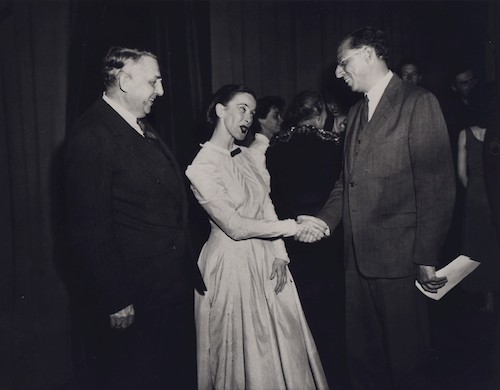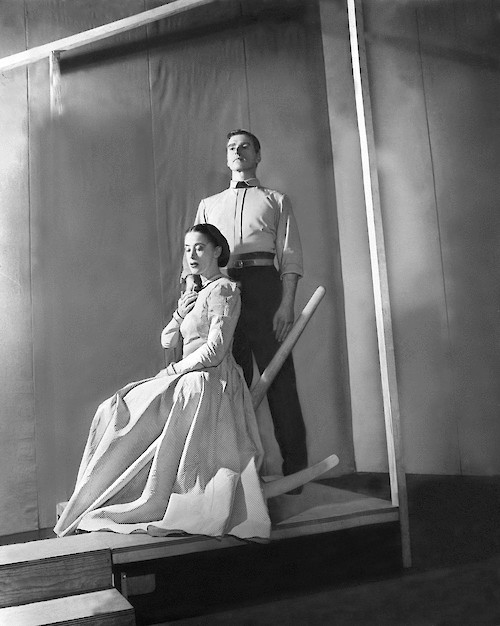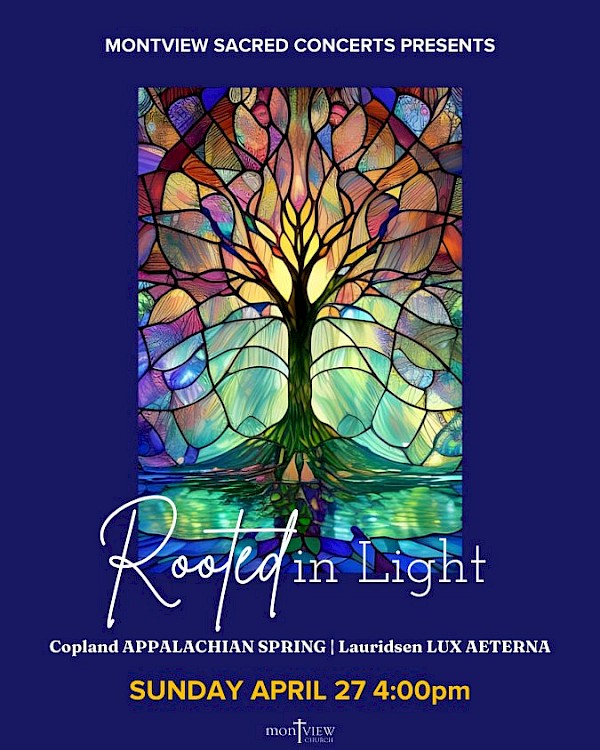When Appalachian Spring was premiered 75 years ago this October, an American classic was born. On October 30, 1944 audiences first heard Aaron Copland’s score, performed as a modern ballet with choreography by Martha Graham. Graham danced the premiere with her company at the Library of Congress, accompanied by thirteen instrumentalists. Appalachian Spring was the last of three modern ballet scores on the evening’s program, all of them commissioned for Graham. After Copland shortened and rescored it for full orchestra in 1945, the work quickly entered the symphonic canon as a suite.

Appalachian Spring was a collaborative venture from the outset. In 1942, Graham asked Copland if he would write a new piece of music that she could choreograph. After he agreed to the project, she sent him a series of scripts that described a farm house, a pioneer wedding, and a young couple facing a future of joys and unknown hardships. By the time of the premiere, the description printed in the playbill read: “Part and parcel of our lives is that moment of Pennsylvania spring when there was ‘a garden eastward in Eden.’ Spring was celebrated by a man and woman building a house with joy and love and prayer; by a revivalist and his followers in their shouts of exaltation; by a pioneering woman with her dreams of the Promised Land.” The characters Graham decided upon were the Bride, danced by Graham, the Husbandman, danced by Graham’s future husband Erick Hawkins, the Pioneering Woman, the Revivalist, danced by Merce Cunningham, and the Revivalist’s four young, female followers.
Shaker elements appeared early in Graham and Copland’s collaboration. Copland found the tune “Simple Gifts” in a book of Shaker songs edited by Edward Deming Andrews shortly after its 1940 publication. The collection’s title came from the song’s first line: “The Gift to be Simple.” He quickly identified it as a promising musical theme. Copland later described to scholar Roger Hall his “instinctive feeling of empathy” with the tune upon first playing it. Copland’s use of the tune in Appalachian Spring is responsible for its later popularity. Today the melody, composed by Shaker Elder Joseph Brackett, also circulates as a folk hymn, “Lord of the Dance,” and in the popular Riverdance production from the 1990s.

Copland presented “Simple Gifts,” with variations, at the midpoint of the ballet, a section Graham wrote should have “no violence, no disturbance. It has a warmth and a kind of sweetness that need in no sense be sentimental. This can be the core of the piece…” Shaker influence also appeared in Graham’s early scripts. In the opening tableau, she wrote, “The first light touches the face of the Mother. She sits on the porch in the rocking chair. It should be like a Shaker chair, simply and beautifully designed.” The use of Shaker imagery was not literal or representational. Rather, Graham and Copland used Shaker elements, among others, to evoke a simpler, rural American past.
Graham provided Copland with a list of eight main sections. After a Prologue come Eden Valley, Wedding Day, Interlude, which includes the variations on “Simple Gifts,” Fear in the Night, Day of Wrath, Moment of Crisis, and The Lord’s Day, which reprises the Shaker melody and closes gently, “like a prayer.” Copland worked out timings for each section and wrote music of the appropriate length to fit each section’s mood. For example, to describe the closing minutes of the work, Graham wrote “The entire piece ends quite simply. It has the feeling of the town settling down for the night, the kind of thing that happens when one hears a call in the twilight, the voices of children in the distance, a dog barking and then night.” Copland’s music returns to gentle, contemplative chords like those heard in the work’s introduction, marked quiet and “very calm” in the score.
By June of 1944, Copland had completed a thirty-minute piano score that fit Graham’s scene descriptions and timings. He scored it for thirteen instruments: flute, clarinet, bassoon, four violins, two violas, two cellos, a double bass, and piano, the maximum number that would fit in the pit at the Coolidge Auditorium. He had planned a three-month trip to Mexico that summer. Before leaving he and the pianist Leo Smit made a recording of the piano version in a studio in Queens. They sent the recording to Graham, who was staying at Bennington College in Vermont, so she would know the tempos Copland had in mind.

After she received Copland’s completed score and recording, Graham stopped referring to her scripts. She created the dance using Copland’s music as her primary inspiration. Unlike the choreographers with whom Copland had previously worked – Lincoln Kirstein for Billy The Kid and Agnes De Mille for Rodeo – Graham felt no obligation to follow her own scripts. While working on the choreography, she confessed to Copland, “I have been...cursing over that not-so-good script. But what you did from that has made me change in many places… It is simply that the music made me change.”
The Library of Congress was more than just the site of the premiere. The funding for the commission from Elizabeth Sprague Coolidge, an arts patron whose foundation was administered by the Library’s Music Division. The Music Division’s chief librarian, Harold Spivacke, negotiated the terms of the contract, booked the hall, hired the instrumentalists, and prodded or reassured Copland, Graham and Coolidge as necessary. The project nearly foundered when Graham’s scripts were late, Copland asked for an extension due to a conflicting commitment to write a Hollywood film score, and Coolidge considered cancelling the commission. Spivacke’s gentle diplomacy saved the ballet. Postponed from its original 1943 premiere date, the work’s first performance was set for October 30, 1944 in the auditorium named after Coolidge, which is still located in the Jefferson Building of the Library of Congress in Washington, D.C.
The premiere received little attention in the New York press, mainly because publicity was released late, and critics in New York had already planned to attend other events that week. But Coolidge Auditorium was full, and the reception was warm. The work’s tone, at once hopeful, celebratory, and nostalgic, resonated with the national mood of optimism as the tide of World War II began to turn in the Allies’ favor. By the time New York audiences saw the ballet—on May 14, 1945—the score had already won the Pulitzer Prize for Music.
Copland soon created a suite version of the ballet. He cut out about ten minutes of music and increased the instrumentation to full-orchestra size. The orchestral suite was premiered in October 4, 1945 by Artur Rodzinski and the New York Philharmonic, and in that form, it has become widely known. Additional versions of the ballet emerged over the years, combining elements of both the original thirteen-instrument ballet and the full-orchestra suite.
Despite claims to the contrary, a full-orchestra version of the complete Graham ballet did not exist until 2016 when one was created for performances of the Graham choreography in Dallas – the Meadows Symphony Orchestra and the Meadows Dance Ensemble at Southern Methodist University, May 2016 – and Baltimore, June 2016, where dancers from the Baltimore School for the Arts performed with the Baltimore Symphony Orchestra directed by Marin Alsop.
Major concert performances in 2018 included John Wilson’s with the BBC Philharmonic in London and the BBC Scottish Symphony Orchestra in Glasgow in March, Gustavo Dudamel’s with the Los Angeles Philharmonic in October, and Marin Alsop leading the Gewandhaus Orchestra in November. At least 150 additional performances in the past three years have occurred, in North America—Boston, Cleveland, Denver, Edmonton, New York, San Diego, Winnipeg—and abroad, in Berlin, Geneva, London, Paris, Vienna, and many other cities.
In March 2017, the Frequent Flyers Aerial Dance ensemble brought a unique aerial choreography to the Kennedy Center. Five more choreographies have been created to Appalachian Spring in recent years: “Angels in the Architecture” by Mark Godden for the Milwaukee Ballet, Paul Vasterling’s choreography done with the Nashville Symphony, David Parker’s “Simple Gifts,” presented at the Theresa Lang Theater in New York in 2017, and Gonzalo Galguera’s “America Noir” in nine German performances by Ballett Magdeburg. In Krefeld, Germany, a Robert North dance titled “Living in America” is enjoying a multi-season run using excerpts from the complete ballet for full orchestra along with additional music by Copland and other American composers.
A rare performance of the ballet with Graham’s choreography will take place at Montclair State University on Copland’s birthday, November 14, when the International Contemporary Ensemble will perform with the Martha Graham Dance Company.
This October (3-6), Gustavo Dudamel and the Los Angeles Philharmonic will present the Appalachian Spring Suite for Orchestra in Walt Disney Concert Hall. Other performances are scheduled by the Nashville Symphony (March 2020) and the Philharmonic Orchestra in London (May 2020). Performances by German orchestras have been announced in Köln, Konstanz, Siegen and Berlin, as well as Austrian performances in Eisenstadt and Vienna. Find upcoming performance listings here for more details.
The Chamber Music Society of Lincoln Center will present the Suite for 13 Instruments in New York in October, also taking it on tour that month. In November and December, the Saint Paul Chamber Orchestra, conducted by Chia-Hsuan Lin, will perform the Suite for 13 Instruments along with Copland’s Short Symphony and other American works.
In additional news, the original ballet that Graham premiered 75 years ago is being published this season (2019-2020) in a scholarly edition for the NEH-sponsored MUSA series (Music in the United States of America), with newly engraved performance materials available through Boosey & Hawkes. The edition is illustrated with more than 300 images taken from the 1958 film of Graham dancing the role of the Bride.




